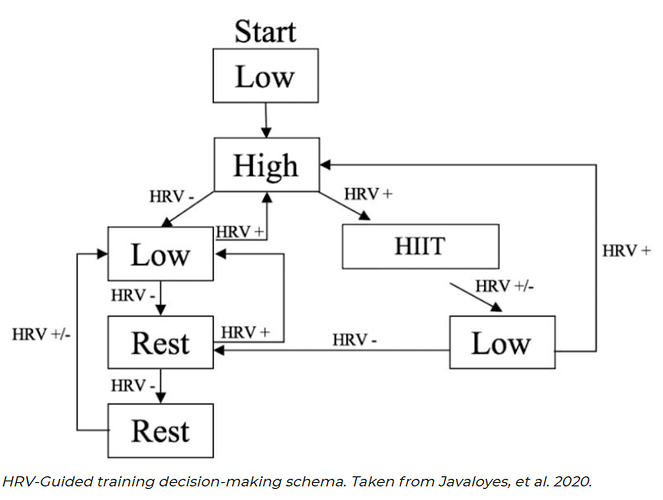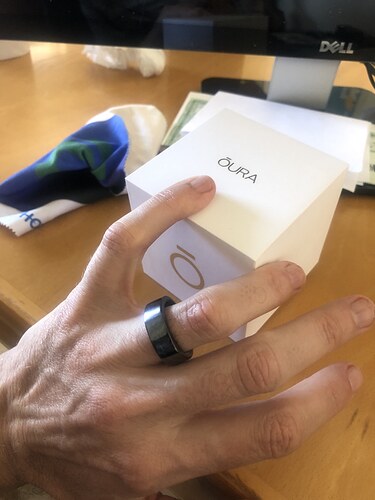I stumbled across these articles on Pez Cycling News which I found interesting. Have any of the HRV advocates out there tried using this or a similar HRV-Guided training approach?
Nice flowchart!
I started using HRV measurements this January and I’m looking into the practical use of it for guided training. I’m combining it with a Polarized training plan. I use the Kubios app for morning measurements and this app gives you a “Readiness” score. It is similar to the “Recovery Points” in HRV4Training app and the score in EliteHRV. A user-friendly score to help you make decisions.
The Kubios Readiness has 4 zones: High, Normal, Low and Very Low. My take on this at this moment is as follows:
- Normal: proceed as planned
- High: If you have a HIT training planned in the next coming days, do it today
- Low: only LIT Endurance training
- Very Low: Rest day or easy recovery training
I have been able to increase my weekly workload considerably while feeling better balanced then without the use of the HRV scores. The number of sessions that are swapped around is not very high, but it seems to have an impact. I realize that all this is far from scientific research and can’t be used to prove anything. It’s just my personal experience with it for a very small timeframe.
Interesting, your approach does sound very similar to that flow chart. Glad to hear you have had positive results so far. Thanks for sharing!
I also stumbled upon the article and find the application of HRV measurements interesting.
However I find it strange that the flowchart never allows for two consecutive days of low intensity training.
Once you have finished a low intensity training the only option is to go back to high intensity or rest. On the other side the only possible way to get to HIIT is to do it after a high intensity day.
This makes it impossible to have “normal” structured week like 1 rest day, 2 high intensity days and 4 days of low intensity to get a decent amount of training volume while having a good intensity distribution.
When you go about HRV, think about it too:
This is an approach to a different problem - measuring resting HRV is supposed to give you a sign how well the body is rested and if it is ready for high intensity workload.
Measuring HRV during the workout and computing metrics like DFA’s alpha 1 is still quite new and experimental and is supposed to give you a hint if you are below the aerobic threshold or not while exercising.
Thanks for this post, I’ve been tracking my HRV for quite some time but haven’t been too serious about adjusting my training accordingly. I track via an Apple Watch and the Training Today application. Also recently stumbled on Triathlon Talon’s Excel sheet.
I’m a 38 year-old health care administrator with a 1.5 year old boy. Needless to say, the last year has been pretty difficult and I am starting to realize that my recovery might be suffering.
I have TrainerRoad subscription and am on a low volume training plan, there is a lot of intensity. The only time that I have endurance rides on the schedule is during recovery week.
My plan moving forward is to adjust my schedule according the the Training Today result from my morning reading. Green, go for the high intensity workout; Yellow, it depends on how high in the yellow range and how I’m feeling, will work somewhere between tempo and sweet spot; Red, rest or lower on the endurance range. Example, I’m 7.7/10 in Training Today right now so doing Mt Hale outside with maybe some extra endurance mileage.
Finally, the question, what exactly do these studies mean by high intensity? Threshold, VO2? I’ll be able to fairly easily find the endurance and sweet spot (few) rides but could use some advice on the higher intensity stuff.
Usually they refer to a 3 zone model, where zone 1 is low intensity up to aerobic threshold, zone 2 is tempo up to anaerobic threshold and zone 3 everything above anaerobic threshold (VO2max).
Everything in zone 1 is considered low, zone 2 + 3 form high intensity. So sweet spot workout would, under this definition, already fall into high intensity since it should be above the aerobic threshold.
Great, thanks. So by this logic I can just do whatever workout is on the TrainerRoad plan on green/high yellow days, swap endurance rides on yellow/high red days and full rest or active recovery on solid red.
Found the complete study. It’s been done on runners and the intended intensity distribution was 50-50 High-Low. That’s why the original flowchart was modified.
Yes I am keen to look at that as well. Still trying to find out if a Polar H10 strap will record HRV on a Garmin Edge 130+. I don’t want to buy one if I also have to get a new cycle computer.
I get HRV on an Edge520. I thought the Edge130+ had a similar feature set so I think the odds are good.
This could be helpfull if your Edge 130 does not record HRV out of the box:
Under the picture of the watch there is a link to github with a fit file that is supposed to activate HRV on older watches. May also work on your Edge 130.
Tx guys. I think I will get a Polar H10 and see.
Awesome, I really like my Oura ring. Also nice to be able to wear a non-sports watch every once in a while without going through data withdrawal!!
How thick does the Oura feel on your finger? My wedding band is on the thicker side and I haven’t worn it since our wedding day; Enso silicon instead.
Would consider an Oura but don’t know if I deal with the thickness.
I still know it’s there but its not bugging me much. Before this I didn’t wear any ring. If you can get the sizing kit from someone you can try that. The plastic rings in the kit are the same size as the real thing.
Tx. I copied this file into my NEWFILES folder on my Garmin Edge 130+, synced with GC on my phone, restarted the Garmin and it worked.
I have an easy 2h ride today so will look at that data.
Nice!

